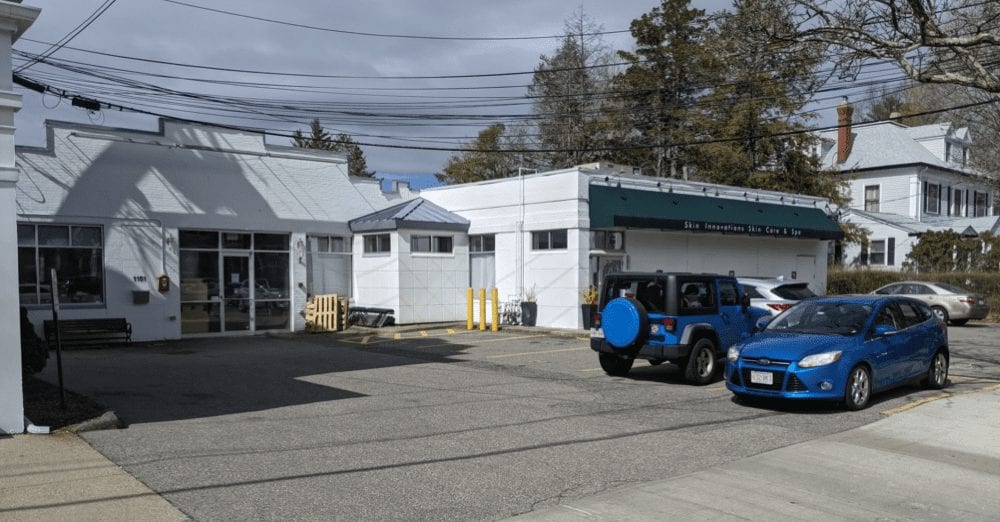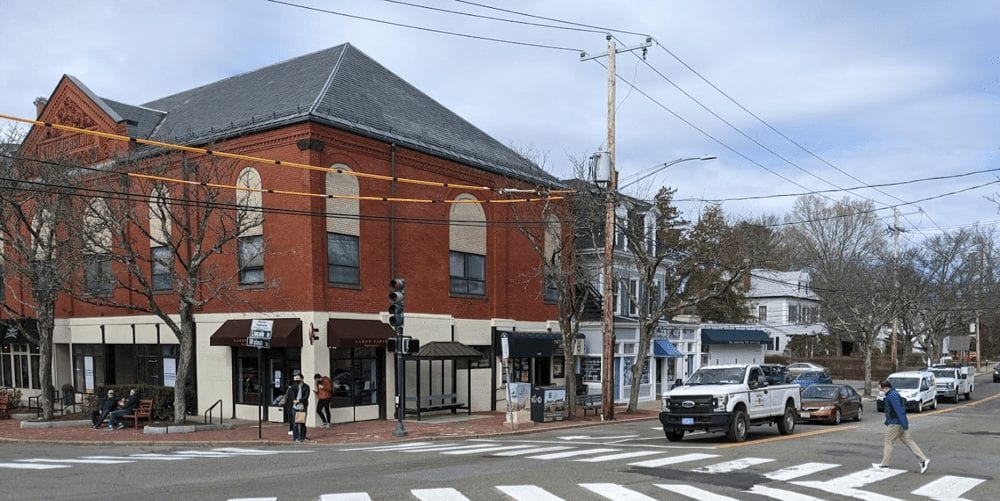Tonight, the Land Use Committee of the City Council will discuss a 25-unit apartment building across Walnut Street from the Highland’s T station. The meeting agenda includes a Zoom link. The meeting begins at 7; the rezoning required and the apartment proposal itself are the fourth and fifth items on the agenda.
The proposal touches on a number of interesting topics: village center revitalization, affordable housing, density, the extent to which Newton zoning discourages multi-unit residential development, parking, &c.
The project will raze existing, one-story commercial buildings on two lots, 1149 and 1151 Walnut St. (6,000 and 7,050 s.f.) 1151 is actually an off-street lot with access through 1149.
If I remember correctly, this was a gas station as recently as 20 years ago. (The oldest Google Maps photo available is from 2007.) The building to the right held the service bays, the pumps were in front of the building to the left.
The buildings to the right and the left of 1149 and 1151 Walnut are significantly taller and the buildings to the left are not set back from the street the way 1149 and (particularly) 1151 are.
The proposal is for a 4-story, 44-foot tall mixed-use building that shares the same setback as its neighbors. (The far righthand portion is 3-story, 34-foot tall, reduced in response to neighbor feedback.)
The 25 residential units include studios (389 – 686 s.f.), one bedrooms (595 – 686 s.f.), and two bedrooms (849 – 1068 s.f.). Five will be permanently affordable units, per the city’s Inclusionary Zoning requirements, with four of the units available to folks with 50-80% of Area Median Income (AMI) and the fifth available at 110% of AMI.
There will be 23 parking spaces on the first floor, behind the 1,323 s.f. of ground-floor retail or restaurant space, accessible from the right (north) side of the building.
Note: commentary ahead …
This strikes me as exactly the kind of development we should have in our village centers. Ground-floor retail with three or four stories of modestly sized residential units above. The twenty-five new households will provide customers for the coffee shop, little market, restaurants, and other stores in the Highlands. Visually, it’s highly contextual. (Your mileage may vary on whether or not this should be a priority.)
This development should promote lower vehicle miles travelled (VMT) per person or per household, an important city climate objective. It’s directly across from the T, at the heart of a village center, a little over a half-mile from a grocery and a choice of two pharmacies. It’s blocks from both Crystal Lake and Cold Spring Park. It’s a short walk or bike ride from Needham St. This is a place where young professionals and seniors could easily live car-free or car-lite. (The 23 parking spaces are probably too many by half.)
But, goodness the hoops to jump through to build it. As Councilor Bill Humphrey noted in the context of the Fair Housing Month resolution, at a recent Zoning and Planning meeting, the zoning mechanism for this kind of village center-enhancing mixed-use development, the MU4 designation, is not even on the zoning map. A petitioner has to get a zoning change to apply MU4 to a specific lot or lots, as the petitioner is here.
Even with a MU4 designation, the petitioner requires special-permit approval to allow 4 stories, to allow a floor/area ratio of 2.00, to waive the lot area per residential unit requirement, to waive 19 parking stalls, and more. You read that correctly. Zoning would require residences literally across the street from the T to have two parking stalls per unit, with 1.25 allowed per unit by special permit. Arguably, with enough parking, this building may be attractive to households that do not use the T to commute and, therefore, require a car or two. But, if there were fewer parking spaces, it would be less attractive to those households, particularly if parking is (as I expect it will be) provided separately and at extra cost. The parking provided determines the kind of renters who are attracted.
This apartment building and its very modestly sized units is in striking contrast to four recent (within the last two years) developments blocks away, on Centre Street. At 1652 Centre St., a 13,592 s.f. lot, the developer replaced a single-family home with two 4,000 s.f., $1.4 million town homes. A few doors down, at 1664 Centre St., a 9,281 s.f. lot, a developer replaced a two-family home with two 2,005 s.f., $1.1 million town homes. Across the street, at 1657 Centre St., a 9,450 s.f. lot, a developer replaced a two-family home with two 2,032 s.f., $1.2 million town homes. And, at 1659 Centre St., a 6,394 s.f. lot, a developer replaced a two-family home with two 2,950 s.f., $1.35 million town homes.
On an aggregate of roughly three times the lot size of the proposed Walnut St. development, those four Centre St. developments added eight million-dollar-plus condominiums, essentially by right. (I think one of the developments required a special permit.) The density of the Walnut St. proposal is a bit unique to the site, but if those four recent Centre St. teardowns had been replaced at half the unit-density of the Walnut St. proposal, there would have been close to forty more modest units. Even at a quarter of the unit-density, there could have been eighteen or so, as opposed to eight. It wouldn’t even require bigger buildings. Within the same building envelope of the eight town home units, you could fit 22 1,000 s.f. homes!
If you want to know why Newton is getting more millon-dollar-plus town homes and less modestly sized, modestly priced housing, it’s the zoning. The zoning encourages the town homes and discourages multi-family housing. Zoning needs to provide more by-right alternatives to single-family and two-family homes, especially in and near our village centers.
In the meantime, I’m letting city councilors know that I support the Walnut St. proposal.




This sounds like a great project to me – given the eyesore that’s currently there, I can’t believe anyone would be opposed. It would be nice if they could somehow include an improved bus stop for the 59.
This looks like a great project and a perfect example of how and where multi-family fits in Newton. To me it’s vital that we oversee new projects of this type in order to ensure they are attractive and appropriately scaled. I would however concede the point to Sean that some of the hoops that this particular project has had to jump are a bit much.
Excellent project!
It’s a shame 1114 Beacon isn’t doing something similar, providing mixed-use and contributing to a village center. NHNAC minutes suggested there was pushback against including commercial space on the ground floor there, even though the developer wanted to.
389 sf?
That’s less than 20 ft by 20ft “studio”.
One bedroom 689 sf? Man those are tiny.
In addition to the Newton Highlands T stop, the 59 Bus route which runs from Watertown Square to Needham Junction has a stop conveniently located at the corner of Walnut & Lincoln
Yes, this is a great project. But Sean I am really at a loss as to why you would speak in favor of 145 Warren Street where a developer is peddling a project that would replace a single family modest historic home (2300 sq feet) with four luxury units that would sell for $1,400,000 each and would add a parking garage for 8 cars on a block that has nothing larger than 2 units as a transit oriented development.
Oh my stars and garters, Sean Roche and I agree on something. This project makes sense for the community and its potential new residents. More people to support these fantastic new businesses already in the Highlands (e.g. Lakon patisserie)! A good residence for people thinking of moving to Newton from either Cambridge or Boston because it still has transit access. Gives them the opportunity to find out Newton is right for them and save some money on rent for a downpayment for a house here. We should just make sure the city council squeezes as many concessions out of this developer as possible.
@Adam, even pre-COVID, the bottom has rapidly fallen out of the commercial retail market, because of online shopping. COVID just released the brakes on the freefall. Unrented residential space still pays the same in property tax while commercial space depends in part on the rents the landlord can get. Even when this pandemic ends, I suspect that online shopping will still drive a stake through the heart of local retail businesses. It’s a shame, but it is part of the changing commercial landscape.
@Ted, perhaps so. Village centers face some serious challenges. Still, service-related businesses could be tenants. In the April 1 minutes I read from the NH area council (no fooling) it sounded like it was still the developer’s preference to build mixed-use at 1114 Beacon. I haven’t been following closely enough to understand what the objections were to commercial space on the ground level, but the concerns came from abutters so they must not have been financial. Anyone know what they were?
Four Corners has always been an odd collection of strip malls. There’s the potential to turn it into something more coherent, and I don’t see any sort of vision coming together.
Every opportunity missed for walkable, bikeable, practical, convenient, appealing retail garrantees a perpetual set of driving errands for surrounding residents. Omitting it, or leaving it unoccupied, is a failure that keeps on giving in car trips and wasted time.
Local retail defines places. Just imagine the Highlands without retail.
Yes, it is a tough market. We have to figure out how to make it work.
Sean, our climate plan calls for a reduction in total VMT, not per capita VMT. To the extent trips are correlated with parking spaces, we need to reduce the number of parking spaces somewhere else by more than the amount this project adds.
Nathan said: “we need to reduce the number of parking spaces somewhere else by more than the amount this project adds.”
Or give more residents more opportunities to get what they need without driving. Car lite is far easier to achieve in Newton than car free. I will take progress one trip, one day, one person at a time. Lots of people cut their driving during the pandemic. That didn’t mean they had to give up their cars completely. It is possible to make real progress through incremental change: we have to build our cities right, though.
https://theconversation.com/cycling-is-ten-times-more-important-than-electric-cars-for-reaching-net-zero-cities-157163
Mike, I found this to be an interesting take on carrots & sticks: https://wecanfixit.substack.com/p/people-lie-about-why-they-drive
Also: there’s a big difference in impact between car access & car ownership.